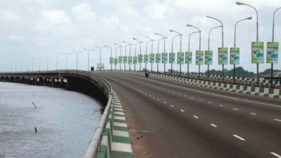By Kayode Ojewale
LAGOS and traffic congestion are synonymous when describing life in the Centre of Excellence. The reason is not far-fetched because the city is heavily populated and still increasing. Traffic situation would have become worse by now if the Lagos State Traffic Management Authority, LASTMA, was not established over 20 years ago given the attendant increasing population occasioned by infrastructural development in the state. LASTMA officials, no doubt, do not only manage and control vehicular traffic but also handle human traffic while on the road.
They help some passersby to cross at times, especially on busy roads where there are no overhead bridges for pedestrians. Most times these traffic managers stop vehicles for school children and the elderly ones thereby distracting them from their primary assignment on the road. That, to an extent might be understandable because school pupils and the aged are fragile and not strong enough to trek long distance or climb stairs.
Traffic flow is impeded when people cross highways where pedestrian bridges are located, thereby giving traffic managers extra work to do.
One begins to wonder why pedestrians find it difficult to make use of the foot bridges built across Lagos. Why will commuters rather prefer crossing busy highways to using the pedestrian bridges? Why would one deliberately embark on a suicide mission knowing fully well the consequence of such action? Is the risk of crossing the highway in a bid to arrive one’s destination on time worth it in real sense? When would all commuters imbibe the culture of using the pedestrian bridge?
Pedestrian bridges are built for safety purposes and to prevent avoidable deaths on the highways, but these bridges have become abandoned and turned to places for buying, selling, alms begging and displaying all kinds of body disabilities. Government spent a lot of money putting modern concrete pedestrian bridges in place in order to ease traffic flow and reduce highway knockdown of passersby crossing the road. Some old bridges were rehabilitated, new ones were constructed and some others left dilapidated. On the side of officialdom, the maintenance culture is lacking because old bridges are not being maintained. Most old bridges have, due to disuse and disrepair, been left abandoned.
Enforcing the use of pedestrian bridges by commuters will be one good way to prevent or reduce road fatalities. This will be one good way to tame the continued failure of pedestrians to use foot bridges. Despite Lagos State’s attempts and aggressive campaigns in the drive to sensitise its residents to use pedestrian bridges, the efforts have still not yielded the desired outcomes to dissuade people from the unhealthy and dangerous practice of dashing across major highways.
There have been many reports of hit-and-run motorists, who, on daily basis, knock down pedestrians who cross busy highways without using overhead bridges.
While there are still many places in Lagos today needing overhead bridges for pedestrians crossing, it is unfortunate that the existing and newly built ones are not being used by pedestrians. Some old iron-built bridges have also become death traps and may collapse in no distant time. Some abandoned bridges have also become hideouts for pickpocketing and other criminal activities.
Other unused overhead bridges are places of abode for miscreants and street urchins. For anyone who manages to use such pedestrian bridge, they must be mindful of their belongings.
In order to stem the spate of environmental offences, the state government is checking environmental ills in Lagos through the Lagos State Environmental Sanitation Corps, LAGESC, which is saddled with the responsibility of arresting pedestrians who fail to use the footbridges.
It will be recalled that LAGESC officials in 2020 arrested and prosecuted some defaulters who failed to use the pedestrian bridges built strategically for crossing highways. Many arrests have been made in time past, yet the prosecution of these defaulting pedestrians have not deterred others from committing same offence.
The Corps Marshal of LAGESC, CP AkinpeluGbemisola (rtd), sometime last year, encouraged pedestrians to make use of the bridges for free flow of traffic and the people, warning that it is an offence to endanger their lives by crossing the highways which puts them at risk of getting knocked down by ‘hit and run’ drivers.
Pedestrians are their own enemies; apart from their failure to use footbridges, walkways and sidewalks meant for them have been turned to market places.
Traffic congestion is triggered in some areas, especially busy bus stops where pedestrian movement surpasses vehicular movement, by those who buy and sell by roadsides. The obstruction by these buyers and sellers become worse as from twilight when there is heavy human and vehicular movement. Lazy buyers that could not walk into the main market patronise sellers by roadsides and on the sidewalks, thereby encouraging these violators to continue their unguided practices.
Reasons some pedestrians do not use the foot bridges range from, laziness to walk the long stretch of thebridge length to hurriedness to arrive their destinations. Whereas in reality, the foot bridges help save the time pedestrians waste by waiting for vehicles to speed past. Some also claim their fear for height is the reason they cannot climb staircases, adding that the bridge can collapse too.
One good way of ensuring that pedestrians use the footbridges is by making public the continuous arrest and prosecution of offenders who cross highways. The publication of the names of defaulters and offenders in media space would serve as deterrence to pedestrians with such intentions. Pedestrian bridges should also not be constructed too high to cater for the acrophobic folks.

